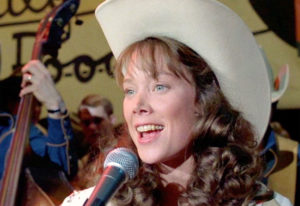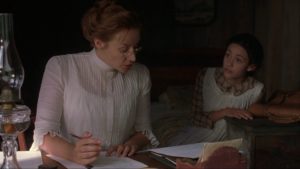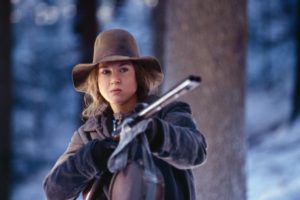In the second half of Movie-Made Appalachia: History, Hollywood, and the Highland South, author and University of Georgia professor John Inscoe pivots to the portrayal of Appalachian women on the big and small screen.
In earlier films, Appalachian women – often older character actors – play supporting or subsidiary roles in the narrative. But more recently, as in The Dollmaker, they have been at center stage.

Coal Miner’s Daughter (1980) puts country music icon Loretta Lynn in the spotlight with a feature film based on her autobiography. Starring Sissy Spacek with Tommy Lee Jones and Levon Helm, it gets high marks from Inscoe for its portrayal of a Kentucky coal town.
Connecting Nancy Morgan’s Story to Best-Selling Novel Christy
Catherine Marshall’s 1967 best-selling novel Christy tells the story – based on Marshall’s mother’s life – of an idealistic young woman who goes to the mountains of East Tennessee in 1912 as a missionary, teaching at a Quaker school in the fictional community of Cutter Gap. In 1994, the book became a television movie and then a series.
Christy’s story contains eerie echoes of Nancy Morgan’s experience in Madison County, which I cover in Met Her on the Mountain. Nancy brought the novel with her in 1969 when VISTA assigned her to Shelton Laurel, where some of her experiences and feelings duplicated her literary predecessor.
What Inscoe writes about Christy’s experience in the film and series could easily apply to Nancy Morgan’s experience in Madison County: “What little impact these benevolent workers have is modest and achieved only incrementally while the major issues of poverty, moonshine and feuding remain as daunting by the film’s end.”
Appalachian Women in Songcatcher and Cold Mountain

In the independent film Songcatcher (2000), which involved a number of Madison County residents, including singer, author and folklorist Sheila Kay Adams, three of the four major characters are strong, outspoken Appalachian women. The movie is a fictionalized retelling of Olive Dame Campbell, who traveled to the Southern Mountains, including Madison County (where it was filmed), in the early part of the 20th century, collecting English ballads.
Inscoe calls the film “the most ambitious and sophisticated treatment of ‘culture brokers’ in Southern Appalachia,” one which “suggested more complex dynamics at play in terms of how outsiders interacted with outsiders and the impact of that interaction on both.”
Later, Inscoe repeats and expands his praise, calling Songcatcher “the most serious and sophisticated treatment of Southern Appalachia ever captured in a feature film.”
In addition to treating locals with respect, the film “adds to that a sense of savvy, self-awareness, and pride on the part of highlanders who refuse to let themselves become mere pawns for those coming in to ‘uplift’ them.”

Cold Mountain (2003) puts two strong women at the center of the narrative of the Civil War on the brutal home front. One, Ruby Thewes, is a colorful native whose portrayal earned Renee Zellweger an Academy Award. Ada Monroe, a relative newcomer from South Carolina, is played by Nicole Kidman. Together, they battle bushwhackers, deserters, and members of the Home Guard, long enough for Ada to be reunited with her fugitive lover, Inman.
Appalachian Women Who Fight Back
And finally, fighting back is another theme Inscoe returns to.
John Sayles’ Matewan, he writes, is “the most ambitious and sophisticated attempt by a filmmaker to portray the historical reality of the coal wars of the 1910s and 1920s, despite its low budget and the relatively small scale of the story it tells.”
The film, dealing with the violent struggle between ruthless coal company owners and hired thugs, and a diverse group of striking miners, “provides as full-bodied a portrait of an Appalachian community as any onscreen.”
Be sure to check out the first two installments of this blog series, “To See Ourselves as Others See Us”: The Southern Appalachians on the Screen (Part 1) and Race and Racism in the Southern Mountains (Part 2).
For information about my upcoming book tour, click here.
Follow me on Facebook, Twitter, and Instagram to learn more. The quickest way to reach me is by email: osopinsky@gmail.com.